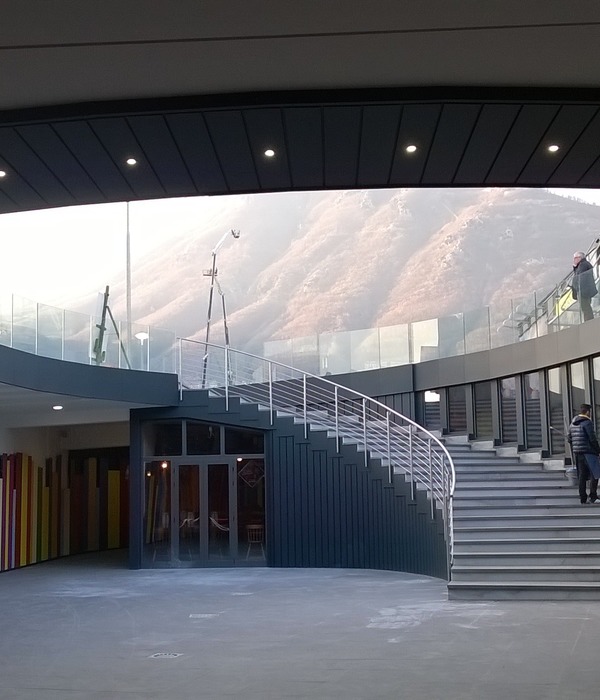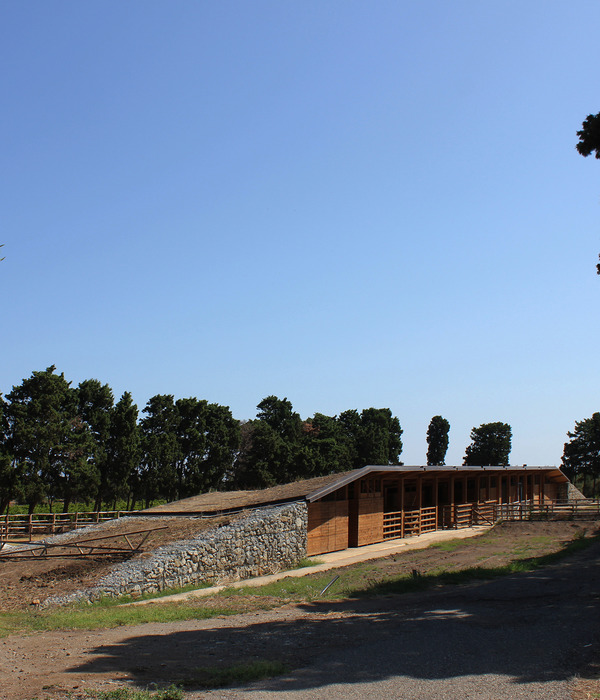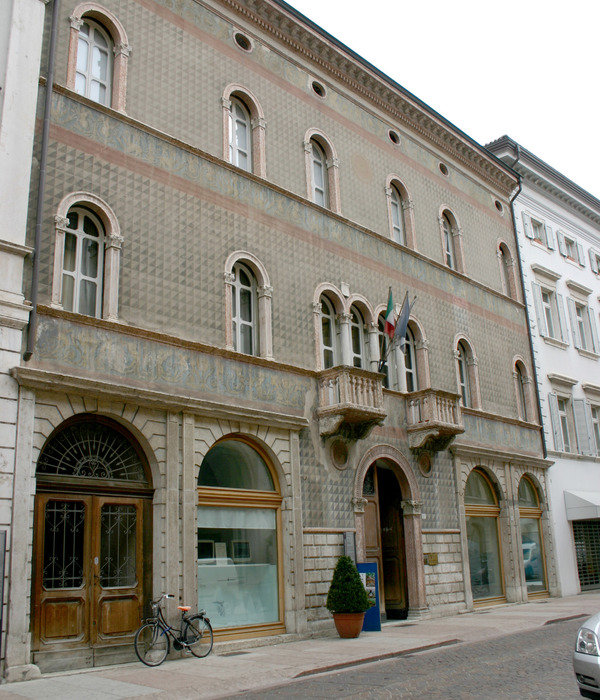- 项目名称:寿县文化艺术中心
- 设计方:朱锫建筑事务所
- 公司网站:www.studiozhupei.com
- 联系邮箱:media@studiozp.com
- 主持建筑师:朱锫
- 设计团队:由昌臣,Shuhei Nakamura,刘伶,吴志刚,杨圣晨,杜扬,柯军,丁新月,吴禛和,杜瑶
- 项目地址:中国安徽,寿县
- 建筑面积:30010平方米
- 摄影版权:苏圣亮
- 结构和机电:北京建院约翰马丁国际建筑设计有限公司
- 景观:朱锫建筑事务所,中国美术学院风景建筑设计研究院
- 室内:朱锫建筑事务所,中国美术学院风景建筑设计研究院
- 客户:寿县人民政府
- 清水混凝土:安徽华城混凝土有限公司
- 铝合金幕墙:山东金象铝业有限公司
- 玻璃:无锡耀皮玻璃工程有限公司
寿县位于安徽中部,淮河中游南岸。历史上曾是楚文化的故乡,也是淮南王刘安著书立说的地方。古城平面略呈方形,围以城墙。墙体以土夯筑,外侧砌砖,外壁下部有高条石砌基,通体向内欹斜,层层收分。城外东南为濠,北环淝水,西接寿西湖,远眺八公山。行走于古桥之上,漫步于古城之间,很多不同时代的遗迹,凝聚着厚重的历史记忆,让人浮想联翩。山、水、城、以及人的活动构成了环境的独特经验感受。实实的城墙将城内乱乱的、松松的、丰富的建筑包裹得紧紧的,是环境经验的骤然切换。
▼主入口,The main entrance ©苏圣亮
Shou County is located in the center of Anhui Province, on the south bank of Huai River. In ancient times, it was the home of the Chu culture and where Liu An, King of Huainan, edited a compendium of ancient Chinese philosophy and composed poetry. The old town of Shou County is roughly square in shape and surrounded by rammed earth walls, with the outward-facing sides of the walls covered in birck above an elevated stone foundation. The entire wall is inclined slightly inwards to allow the stone layers at the bottom to sit firmly in place. The city moat lies to the southeast of the city; Fei River to the north; Shouxi Lake to the west; and Bagong Mountains can be seen in the distance. A walk across the ancient bridges, a stroll through the old town, or an exploration of the ancient relics can offer boundless inspiration. The city walls wrap tightly around the chaotic, scattered, and diverse buildings of the city, creating a sudden change in the experience of the environment once the threshold is passed.
▼轴测图,Axonometric drawing ©朱锫建筑事务所
城内建筑的类型是院落式的,它既不同于北方的院落住宅,也有别于安徽南部的徽州民居。它保持着南方建筑垂直院落的形制,窄窄的街道,小窗、实墙,以抵御冬天的寒冷,夏天的阳光。这些古城的形态,建筑的类型,映射出强烈的自然气候特征,以及当地文化及生存方式的特征。
The buildings within the city are constructed in the courtyard house typology, which differs from those in northern China and the Huizhou houses in southern Anhui. The typology of the buildings in the old town of Shou County strongly reflects the characteristics of the region’s climate, as well as the local culture and way of life. Along the narrow streets, the vertical courtyard houses have small windows and solid walls—a typical weatherproofing feature to protect occupants from the cold in winter and heat in summer.
▼鸟瞰,Aerial view ©苏圣亮
文化艺术中心建在古城的东南一两公里外的新城,过去是农田,空旷、平坦,缺少树木。周边已经建造出我们这个时代典型、但索然无味的高大建筑。这些建筑既不反映当地的自然气候特征,又与当地的文化没有任何一点关联。苍白的地段,似乎就像一张白纸,可以任意想象。县领导也非常开明,没有就设计提具体要求,只提出“一定要快,明年完工”。看似一切顺利简单,不过,直觉告诉我,这活并不好做。
Shou County Culture and Art Center was built in a new city one or two kilometers southeast of the old town, on what used to be empty, flat farmland with a lack of landscape features. Many new tall, generic buildings surround the area and fail to reflect the local climate and local culture. The blandness of the project site resembled a blank piece of paper for Zhu Pei offering the potential for a multitude of creative opportunities. The county government was open-minded in that it didn’t insist on specific design requirements, however it demanded the project “be built quickly and completed next year.”
▼总平面图,site plan ©朱锫建筑事务所
文化艺术中心的主要内容是美术馆,文化馆,图书馆及档案馆等。文化艺术中心不是新概念,受影响于前苏联,50-70年代,建造了很多。但今天,它又被赋予很多新的可能,作为城市公共空间的一部分,它的诉求是塑造市民文化活动的公共空间,它应该像松软的海绵,把人吸进去,游走、交流、停留、驻足,而不应是漂亮的雕塑,可望而不可游。
The building needed to include an art gallery, cultural center, library, and archive. Cultural and art centers are not new in China. Many were built between the 1950s and 1970s under the influence of the former Soviet Union. Nowadays, they have been endowed with a range of new possibilities, including creating urban public space for cultural activities. Shou County Culture and Art Center is designed to draw people in to discover and experience it; unlike a beautiful sculpture that can only be viewed but not experienced.
▼主入口与桥,The main entrance and the bridge ©苏圣亮
就像以往构思初始状态一样,第一个涌入我脑海中的问题是:如何找寻寿县地域的自然气候和文化的根源,就成了我们首先要回答的问题。可能是多年的习惯,每到一个地方,我总是希望到这个地域最古老的文化遗存环境中行走,看看老民居,看看遗迹,感悟我们的先人在没有技术的前提下,如何在原始自然和主动建造中寻求平衡。寿县古城中的老建筑给予了我们足够多的启发。垂直院落内向的家庭居住形态、四通八达的窄窄里弄将家家户户彼此相连,这些特征不仅映射出当地人的生存方式,也暗示出当地自然气候的建造法则。重新塑造这样一种生活的、空间的经验,就会让寿县文化艺术中心根植于当地的土壤之中。
▼徽州庭院形态&方案模型,Local Anhui housing typology & conceptual model ©朱锫建筑事务所
Zhu Pei investigated the cultural roots of Shou County, observing old dwellings and ruins, and identifying how ancestors sought balance between the primal force of nature and active construction without modern technologies. The buildings in the old town provided plenty of inspiration. The inward-oriented living patterns of the vertical courtyard houses, and the narrow lanes extending out in all directions connecting houses to one another, reflect the local way of life and hint at the rules of construction for local climate conditions. Zhu Pei reimagined this living and spatial experience to help to embed Shou County Culture and Art Center in the local community.
▼空中院落,Aerial courtyard ©苏圣亮
最早的草图清楚的表达了多个尺度各异的院落被置于相对方正、封闭的矩形块之中,一条蜿蜒起伏,时上时下的公共廊道将它们串联起来。每一个功能拥有两到三个内院,建筑主入口的前院尺度较大,形成了一个公共广场,意味着寿县民居中的前院和“堂屋”,建筑后部的后院又有着寿县民居中“后花园”的味道。这条漫游环道,引导着人们缓步桥上,穿越水面,步入建筑之中。从前院开始,在不打断室内连续性的前提下,人们可以穿梭游览于布满了很多内院的整个建筑。沿着这个可遮阳避雨的环形廊道,参观者时而在一层,时而又到了二、三层,空间变幻莫测,光影时明时暗,去探索发现令人意想不到的惊喜,感悟“藏、息、修、游”所赋予中国传统建筑的艺术精神。
▼徽州本土民居形态,Local courtyard typology ©朱锫建筑事务所
▼分析图:内院+公共连廊,Diagram: the inner courtyards+The public loop ©朱锫建筑事务所
▼草图,sketch Zhu Pei ©朱锫
Multiple courtyards of different sizes are placed in a relatively enclosed rectangular block. They are connected by a winding, undulating public walkway, which is a public loop protected from the sun and rain. The public loop guides people over the bridge, crossing the moat into the building. The extensive front yard at the main entrance forms a public square that represents the tang wu (central room) of typical Shou County residences, while the backyard resembles the back garden of local folk houses. Each program of the building has two or three inner courtyards. From the front yard, visitors can wander all the inner courtyards without interrupting the continuity of the rooms. Walking along the protected public loop, visitors can find themselves at times on the first floor, second floor or third floor. The space is unpredictable, and light and shadow continually shift to surprise visitors, allowing them to feel the artistic spirit of traditional Chinese architecture expressed by the principles of “hide, breath, cultivate, and wander.”
▼自蛇形环廊入口观前院,View to the front courtyard ©苏圣亮
▼蛇形环廊,Corridor ©苏圣亮
▼自蛇形环廊平台观前院,View the front courtyard from the corridor terrace ©苏圣亮
▼二层蛇形环廊与前院,Corridor on the second floor and the front courtyard ©苏圣亮
▼前院,Front courtyard ©苏圣亮
▼自蛇形环廊楼梯观前院,View from the corridor to the front courtyard ©苏圣亮
▼二层蛇形环廊,Corridor on the second floor ©苏圣亮
▼自二层庭院观蛇形环廊,View from the courtyard on the second floor to the corridor ©苏圣亮
▼自蛇形环廊观后园,View from the corridor to the back garden ©苏圣亮
▼后园,The back garden ©苏圣亮
▼三层蛇形环廊,Corridor on the third floor ©苏圣亮
内向型构想是对周边未来发展不可预测的明智选择,也映射了寿县古城历经时代苍苍而自我泰然处之、兼容并蓄的强大的生命力。
The introverted concept of Shou County Culture and Art Center is a sensible choice for the unpredictable future development of the surrounding area. It also reflects the grace, inclusiveness, and vitality of the ancient city of Shou County, which has withstood the test of time.
▼空中庭院与蛇形环廊,Aerial courtyard and the corridor ©苏圣亮
▼庭院与清水混凝土细节,The courtyard and the texture of concrete ©苏圣亮
▼细节,Detail of the Moon Window ©朱锫建筑事务所
▼局部轴测图,Axonometric drawings ©朱锫建筑事务所
▼首层平面图,ground floor plan ©朱锫建筑事务所
▼二层平面图,first floor plan ©朱锫建筑事务所
▼三层平面图,second floor plan ©朱锫建筑事务所
▼屋顶平面图,roof plan ©朱锫建筑事务所
▼剖面图1-1,section 1-1 ©朱锫建筑事务所
▼剖面图2-2,section 2-2 ©朱锫建筑事务所
{{item.text_origin}}












